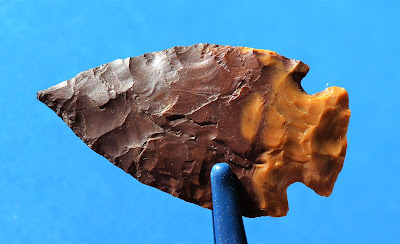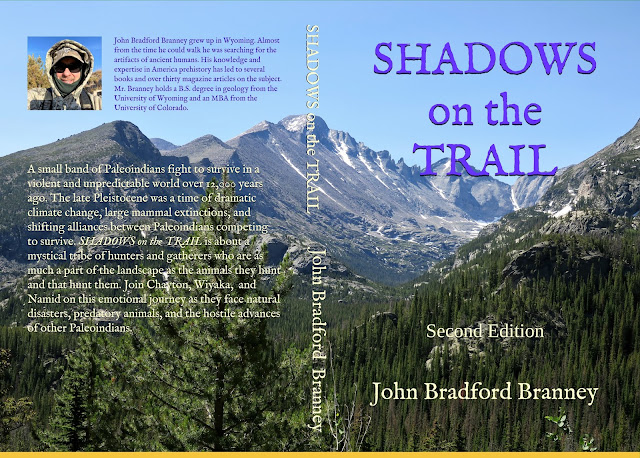Colorado
Ultrathin Knife Form
By John Bradford Branney
 |
Figure One – Ultrathin knife form
surface found on
private land in Morgan County, Colorado.
John Bradford Branney Collection.
|
Figures one, two, and four are
photographs of an excellent example of a surface found, northern Colorado
ultrathin knife form from my collection. It is 71 millimeters long, 48
millimeters wide, and 3.8 millimeters thick in the middle, for a width to
thickness ratio of 12.6. You can see my fingers in figure one showing through the semi-translucent quartzite of this ultrathin knife demonstrating how thin this biface is in the center.
One of
the rarest artifacts to find is a “true” ultrathin knife form. Most of the time we collectors find only pieces of ultrathin knife forms, that is if we find anything at all. I believe that in most cases, prehistoric people "repurposed" the broken pieces or used up ultrathin knife forms into other stone tools or projectile points. People send me photographs all the time, asking my opinion on whether a particular biface is
an ultrathin knife form or not. In most cases, I believe their bifaces are not ultrathin knife
forms, but very nice, well-made biface knife forms or preforms.
How does one tell the difference
between an ultrathin knife form
and a very nice biface or preform?
 |
Figure Two - Profile of Colorado Ultrathin Knife Form. It is 48 mm wide and 3.8 mm thick for width to thickness ratio of 12.6.
|
An ultrathin knife form was a specialized tool form made
by highly skilled knappers using a specialized flaking technology.
Ultrathin knife forms are most often associated with the Folsom Paleoindian Complex, but unless a person recovers the ultrathin knife form within stratigraphic and/or archaeological
context, it is impossible to attribute any ultrathin knife form to the Folsom
Complex, conclusively. Occasionally, later prehistoric cultures used similar flaking technology to create thin knife forms reminiscent of ultrathin knife forms.
The defining characteristics for ultrathin
knife forms are 1). Thinness at a width to thickness ratio of 10:1 or greater (although, I have a few suspected ultrathin knife forms with a ratio of 7:1 or greater), 2).
Biconcave profile (this requirement kills most biconvex bifaces), 3). Oftentimes these knives have a healthy width, 4). Specialized flaking technique (more about this later), and 5). Fine pressure retouch along the
edges, reminiscent of Folsom projectile point retouch. This requirement eliminates most preforms from consideration.
 |
Figure Three - From Bruce Bradley, 1982, Flaked Stone Technology and Typology.
In The Agate Basin Site: A Record of the Paleoindian Occupation of the Northwestern High Plains, edited by G. C. Frison and D. J. Stanford, pp. 181–208. Academic Press, New York. |
Most bifaces have a
biconvex, lenticular, or lozenge-shaped cross-section where the biface is thicker in the center than along its edges. Ultrathin knife forms have a biconcave cross-section where the biface is thinner, or just as thin, in the center than along its edges. It took a specialized flaking technique and great knapping skill to create a biconcave cross-section on a biface. Bruce Bradley called this technique the opposed diving biface thinning technique (figure three, b). He recognized this technique as a Clovis biface thinning technique that was ultimately passed down to subsequent Paleoindian cultures.
To create a biconcave cross-section, the flintknapper removed wide, flat flakes from one edge of the biface. The knapper drove these flat flakes to the midpoint, or just past the midpoint of the biface. Oftentimes, these wide, flat flakes ended in hinge or step
terminations. The knapper then removed similar flat flakes from the opposite edge, but the same side of the biface. These new flakes feathered into the step and hinge terminations from the original flakes, causing more material to be removed from the center of the biface. Note the sequencing of this “diving flakes biface thinning process" in figure three, b.
That was how a biconcave cross-section and
ultrathin knife form was created!
 |
Figure Four – Ultrathin knife form surface
found on private land in Morgan
County, Colorado.
Note the fine retouch along the edge.
John Bradford Branney
Collection.
|











